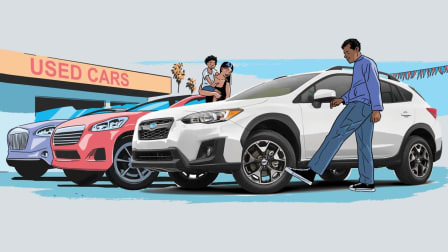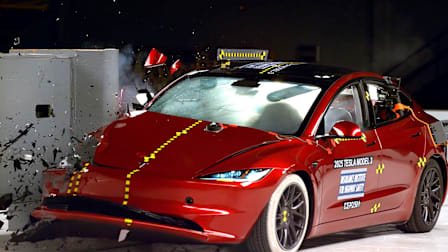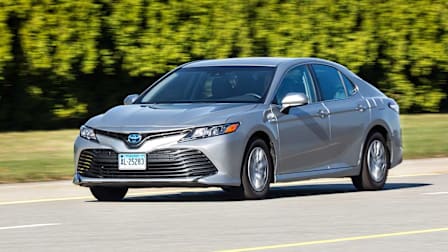Infrastructure Bill Omits Key Safety Features in Cars
$1 trillion in spending planned, but CR says improvements don’t go far enough

The bipartisan infrastructure bill being crafted in Congress would have a major impact on U.S. transportation for years to come.
In its current guise, the $1 trillion legislation includes spending on roads, bridges, rails, and other major projects, as well as provisions aimed at improving safety for motorists, pedestrians, and cyclists. The bill also covers a number of other infrastructure items, including broadband internet access, public transportation, electrical grid improvements, and environmental cleanup.
Separately, there is action this week from the White House to beef up fuel-economy standards and electric vehicle charging infrastructure.
However, for all the good this legislation could do if it is signed into law, Consumer Reports has found that it leaves out requirements for key safety improvements.
Among them: certain types of crash avoidance technology in cars and trucks, better driver monitoring systems to counteract distracted driving, an overhauled five-star safety rating program for new cars, improved standards for seatback construction, better child heatstroke prevention, and a timeline for hood and bumper safety improvements to protect pedestrians.
But it doesn’t address a glaring omission from current vehicle safety laws: allowing used cars that have been recalled to be sold before the safety defects identified in the recalls are repaired.
The Good
Impaired-driving tech: The bill includes a requirement that over the next decade, all new cars be equipped with advanced technology that would prevent drunk and impaired driving.
The systems would passively detect that a driver is impaired, unlike the alcohol interlock devices used in some states that require offenders to blow into them. According to the Insurance Institute for Highway Safety (IIHS), this technology has the potential to save more than 9,000 lives per year—preventing about a quarter of annual traffic deaths.
Recall and safety information: The bill includes requirements for automakers to be more transparent about the performance of safety recalls, as well as improvements to make federal vehicle safety databases more accessible to the public.
Advanced lighting: The bill promotes better headlights in cars and trucks, including adaptive beams that adjust brightness based on traffic conditions to improve visibility.
Crash-test dummies: Crashes affect people in different ways, and a new study will seek to identify ways to improve crash-test dummies so that they better represent women and other demographic cross-sections of the population.
Keyless ignition shutoff: A new requirement will put automatic engine shutoff mechanisms in cars with keyless ignition switches in order to prevent carbon monoxide poisoning from a vehicle that is inadvertently left running.
Safer streets: Included in the bill is the Safe Streets and Roads for All grant program, which is designed to support data-driven local initiatives to prevent road deaths and injuries.
Better data: According to the IIHS, pedestrian deaths currently account for about 17 percent of the 40,000 annual traffic deaths in the U.S. The pending infrastructure bill calls for focused research into the needs of vulnerable road users such as pedestrians and cyclists in an effort to increase their safety on public roads.
The Mediocre
Traffic safety funding: The National Highway Traffic Safety Administration—the Department of Transportation agency responsible for rating vehicle safety, enforcing safety laws, and overseeing safety recalls, among other functions—is chronically underfunded.
The pending infrastructure bill calls for only modest increases in funding for NHTSA. CR has called for NHTSA funding and staff resources to be at least doubled to meet a growing need for roadway safety.
Advanced crash avoidance systems: While the bill includes a requirement that all new cars be outfitted with automatic emergency braking and lane departure warning, it includes no firm deadline for action and leaves out technologies—including blind spot warning and pedestrian detection—that CR considers important to increasing traffic safety.
Driver distraction monitoring: As a number of recent crashes have shown, some current driver monitoring systems are woefully inadequate at a time when drivers are more distracted than ever by smartphones and even by some low-level vehicle automation technology.
While the bill demands a study of the technology, it does not require NHTSA to set standards for driver monitoring systems that could keep people safer.
Five-star safety ratings: Until recently, NHTSA’s five-star safety rating system, known as the New Car Assessment Program, had done a good job connecting consumers to the safest cars available for sale.
But times have changed, and so should the rating system, which has become outdated. The bill does not provide a timeline for NHTSA to complete needed updates to the program.
Seatbacks: Collapsing front seatbacks pose a real threat to both front- and rear-seat passengers during collisions, and current safety standards for seatback strength are decades old.
While the bill directs NHTSA to start the process of updating the standards, it does not require the agency to finish that work, nor does it set a deadline for action.
Hood and bumper safety: Although the legislation includes a requirement for NHTSA to seek public comments on how hood and bumper design can be updated to improve pedestrian safety, there is no timeline for making any changes.
CR has said that setting a deadline is crucial, given the dramatic increase in pedestrian injuries and fatalities in recent years.
Children in hot cars: Every summer, news stories abound about children who die of heatstroke after being left unknowingly in a car on a warm day.
Although the bill requires that new cars be equipped with a reminder to check the rear seat before leaving the car, CR thinks it should be stronger, requiring technology that will detect an unattended child in the rear seat and send alerts after the car has been shut off.
Truck safety: The bill includes requirements that large trucks include automatic emergency braking and better rear underride protection, but these measures don’t go far enough.
CR thinks the requirements should be extended to midsized and small trucks as well—such as box trucks and delivery vans—particularly as their number rises amid a general increase in online shopping and home product delivery.
The Bad
Used-car safety: In the U.S., it is possible to buy a used car that was recalled but never fixed, exposing motorists to potentially deadly safety defects.
Although federal law explicitly prohibits selling new cars that have been recalled but not fixed, no such provision exists for used cars. CR has endorsed legislation that would close this safety gap and thinks it should be included in the pending infrastructure bill.




















